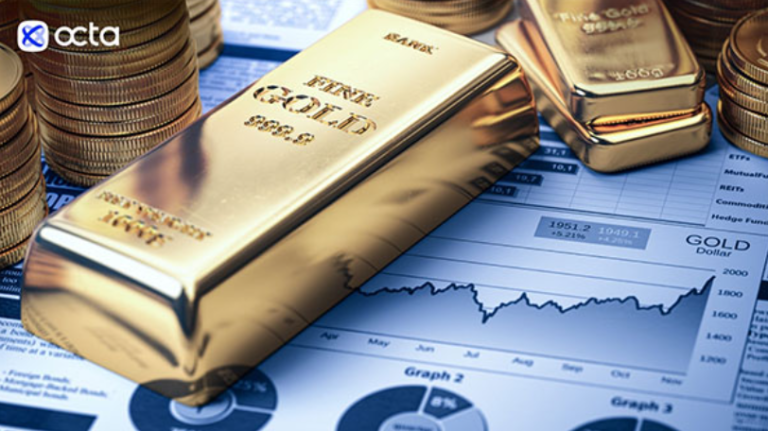Octa Provides Expert Analysis for 2024 for Global Economic Trends and Gold Prices
New Delhi [India]: According to many analysts’ forecasts, the price of gold may increase in 2024. Octa explains in the article what factors will influence the dynamics of the gold price and what will happen to the market this year.
Gold is trading above $2,000 per ounce in early 2024. Analysts expect that even later in the year, gold prices may remain above $2,000 per ounce, reaching new historical highs. Among the factors favouring this are geopolitical uncertainty, the likely weakening of the U.S. dollar, and potential interest rate cuts. But before relying on these factors in the future, we must understand how they have influenced the past.
A new scenario of gold price dynamics
For the past 90 years, the value of gold has depended primarily on the volume of transactions between the Western and Eastern markets. Western countries determined supply and demand, while Eastern countries acted as counterparties to the transaction. Thus, when the volumes of physical gold purchased by Great Britain or Switzerland increased, its price grew, and vice versa. As a result, gold moved from the West to the East and back synchronously with the price decreasing or increasing.
The second factor that has historically influenced the price is the relationship between the price of gold and the real yield on U.S. government bonds. When the real yield decreased, bonds lost their appeal, and investors moved into gold. Once the trend reversed and real yields began to rise, investors returned to bonds.
However, since the end of 2022, both patterns have failed. The U.S. ten-year bond yield rose to 4.33%, above the 2022 highs, beating a 15-year record. Despite expectations, this didn’t lower the price of gold, which instead rose from November 2022 to August 2023 by 16%, from $1,643 to $1,954 per ounce.
The correlation between gold transaction volumes and the gold price also stopped working. Since the third quarter of 2022, the UK and Switzerland have been Netto-exporters of gold, i.e. sellers. According to the historical paradigm, this should also have been a reason for the price of gold to fall. However, as we can see, this is not happening. Thus, the West has not significantly influenced the pricing of precious metals.
What affects gold in 2024?
Escalating geopolitical conflicts are causing gold to rise in value. Due to the geopolitical events of 2022, dollar assets have become more risky for many countries. Central banks in the Global South, Eastern Europe, and the Middle East have been actively pursuing a policy of building up the gold part of foreign exchange reserves since the end of 2022. According to a World Gold Council (WGC) report, central banks bought 800 tonnes of gold in the first nine months of 2023, up 14% year-on-year. Excess demand from central banks has boosted the value of gold by 10 per cent in 2023.
‘It is the central banks’ purchases of gold that will act as the main driver of growth in 2024′, said Kar Yong Ang, the Octa financial market analyst. ‘If the trend continues and the level of gold reserves moves towards an average of 40% of the gold composition in reserves, that would mean an additional $3.2 trillion in the asset–a 25% rise in 2025, which would correspond to a price of $2,500 an ounce’, he added.
Gold has also seen another rise since the beginning of the Palestinian-Israeli conflict: since October 2023, it has added more than 8%. Hence, we can conclude that any aggravation in geopolitics will have a positive impact on gold.
The stabilisation of inflation will continue to support gold quotes. In 2022, global inflation reached its highest levels in decades. However, it is also a fact that inflation passed its peak at the end of 2023. Most analysts believe inflationary pressures will continue to ease in 2024.
‘Traditionally, the gold price has been negatively correlated with the inflation rate. The lower the inflation rate, the lower the interest rates on government bonds. As a result, the relative attractiveness of non-interest-bearing assets such as gold increases’, said Kar Yong Ang.
Developing economies de-dollarisation. Investors see gold as an alternative means of building savings and protection against inflation and currency risk. Demand for gold is increasing because Brazil, Russia, India, and China (members of BRICKS) seek ways to improve their currency independence.
The main factors affecting gold’s price are inflation, rising demand from central banks, de-dollarisation of developing economies, microeconomic situation, and geopolitics. The combination of these factors will create conditions for the growth of gold price in 2024–in the first half of the year, the cost of the precious metal may exceed $2,200 per troy ounce. In the second half of the year, the upward trend in gold is likely to continue, and gold may show a price of $2,300 per ounce, so the average price in 2024 will be $2,170.
Octa is an international broker that has been providing online trading services worldwide since 2011. It offers commission-free access to financial markets and various services already utilised by clients from 180 countries with more than 42 million trading accounts. Free educational webinars, articles, and analytical tools they provide help clients reach their investment goals.
The company is involved in a comprehensive network of charitable and humanitarian initiatives, including the improvement of educational infrastructure and short-notice relief projects supporting local communities.
Octa has also won more than 70 awards since its foundation, including the ‘Best Educational Broker 2023’ award from Global Forex Awards and the ‘Best Global Broker Asia 2022’ award from International Business Magazine.
